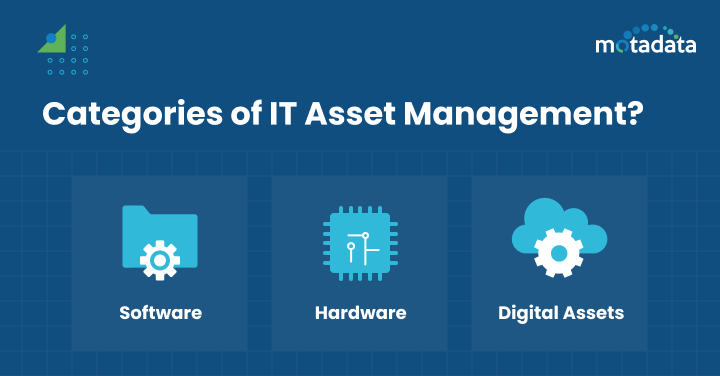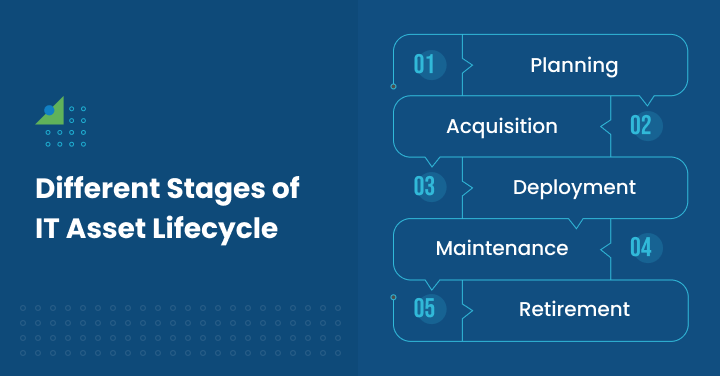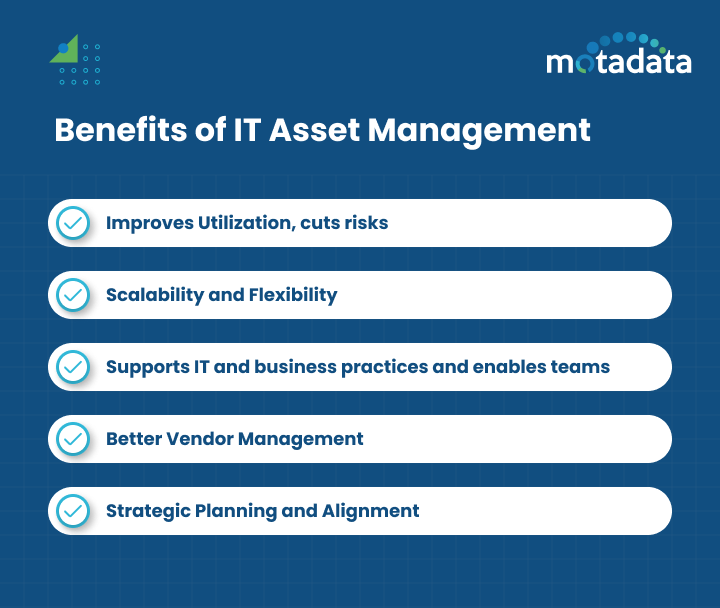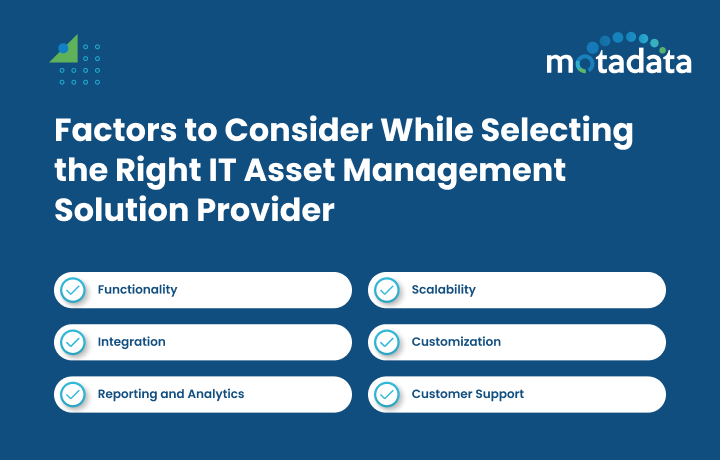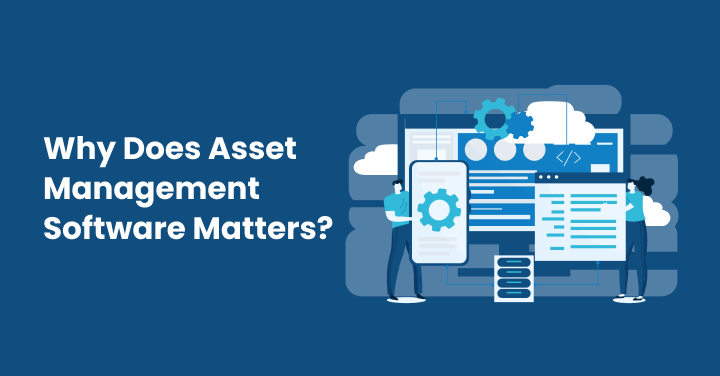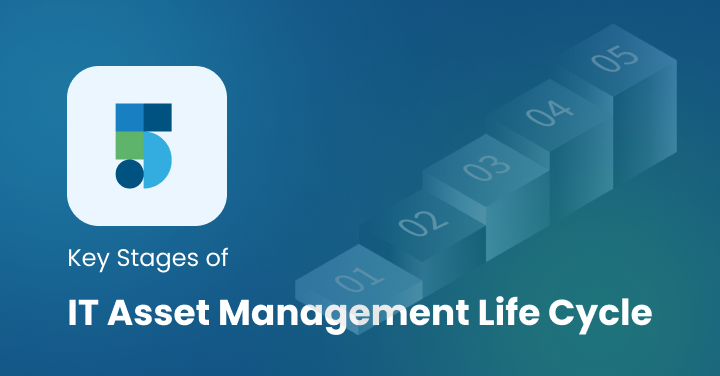IT asset management is an essential component to consider in every organization, regardless of the size and type of its business.
Managing IT assets is critical in today’s technology-dependent business environment, as these assets underpin business advancement and efficiency.
Starting with hardware systems such as servers and laptops and ending with software programs, applications, and cloud resources, these assets’ management is critical to maximizing relevant value while keeping expenses at a bare minimum.
ITAM identifies, manages, and disposes of IT assets throughout their life cycle. It involves identifying the assets, monitoring and managing them, and finally disposing them.
By utilizing ITAM, an organization can adequately use IT resources, properly utilize the data centers, and make decisions regarding future asset purchases.
In the following blog, we will look at ITAM definitions, various categories of IT asset data, the components of ITAM, and the advantages of effective asset management processes will also be described.
For Information Technology (IT) professionals and managers aiming at improving the ability of their organizations to manage firm’s IT properties or the business executives aspiring to make improvements in the management of IT assets, this guide is designed to arm you with all the information and knowledge you require in the field of ITAM.
What is IT Asset Management?
IT Asset Management (ITAM) can be described as a governance process for managing IT-related assets within an organization.
It entails identifying IT assets and monitoring them from their acquisition until they are disposed of.
ITAM’s objective is to help organizations maintain a record of all their IT assets to assist them in outputting the best results concerning the investments made in the IT sector.
ITAM involves many activities, such as identifying, tracking, and maintaining assets and retiring assets.
Having an ITAM practice, which in other words means an organization can track, document, analyze, and store information about its IT assets, will help it make concrete decisions on how to manage IT assets, how to use them, and whether to buy them, maintain them, or throw them away.
ITAM has strong links with IT service management (ITSM) since both fields are centered on IT asset management. Both aim to provide effective services required to support an organization.
While ITSM is all about providing and supporting IT services, ITAM is specific to the management and governance of IT assets.
What are the categories of IT Asset Management?
The IT Asset Management system’s transactions can be categorized into different types depending on the nature of the assets. The main types of ITAM include: The main types of ITAM include:
Software
Though ITAM is a comprehensive practice, Software Asset Management (SAM), a part of ITAM, is mainly concerned with managing software assets in an organization.
This includes their usage in other applications, licensing, and compliance with software usage agreements.
SAM entails the identification and control of software assets from their acquisition to their withdrawal. Software asset management, license management, usage/ reporting, and contract management are some elements.
Hardware
Hardware Asset Management is the process of overseeing tangible IT commodities in an organization. These include servers, PCs, laptops, mobile communication devices, and networking hardware.
Organizations must have a clear picture of each piece of their hardware assets, including where it is, how often it is used, the composition of its maintenance history, and at what stage of its life cycle.
Having the correct information about an organization’s H/W can help the organization make the right decisions about the H/W assets in its possession in terms of acquisition, maintenance, and disposal.
Digital Assets
Digital Asset Management targets managing digital assets within an organization. It champions data, information technology systems, databases, and other technological assets.
Digital assets are part of the current organizational reality, and it remains crucial for modern companies to manage them properly to guarantee high data quality, nonlegal compliance, and smooth business processes.
It includes data inventory control, governance, security, and metadata control.
Important Components of IT Asset Management
IT Asset Management consists of multiple critical components for proper functioning and business organization. These components include:
Asset Discovery
ITAM is comprised of several processes, one of which is Asset Discovery. It can be defined as mapping and documenting all IT resources in organizations, from hardware to software and even cloud.
When all assets are located and documented systematically, organizations can learn about their IT assets’ condition and improve their distribution, making the right decisions about asset purchase and disposal.
Asset Inventory
Asset Inventory can be defined as the process of developing and updating the inventory of an enterprise’s IT assets.
These include server hardware, client hardware, PCs, laptops, and any other handheld devices used in performing business functions.
Ideal asset inventory management will provide an organization with honest and timely details about the location, attributes, usage, and maintenance records of its IT assets.
Asset Lifecycle Management
Asset Lifecycle Management is a subprocess of IT Asset Management that deals with an organization’s lifecycle of assets.
It entails acquiring technologies, implementing them within the organization, supporting, sustaining, and phasing them out.
This is important for hardware assets since they are high-value and fragile and mainly get used over time in an organization. For this reason, they need to be adequately managed.
License Management
License Management is a sub-discipline of IT Asset Management used to manage an organization’s software licenses.
Good and proper License Management guarantees the installation of as many permits as possible per the agreements and ensures that as many licenses as possible are used optimally.
Effective License Management practice means non-interference with the organization’s compliance, eradicating the risk of fines or penalties, and efficiently utilizing the available licenses to achieve maximum ROI.
Compliance and Audit Management
Compliance and Audit Management is one of the modules of IT Asset Management that deals with managing regulatory provisions, compliance with governance rules and frameworks, and preparation for software audits.
Practical Compliance and Audit Management is crucial for managing and addressing legal and regulatory requirements, avoiding penalties for non-compliance, and achieving sound corporate governance.
What is an ITAM Database or SAM Database?
An ITAM Database is, therefore, the management and central data source or records of IT assets in an organization.
This entails physical, financial, and contractual details of IT assets within an organization’s asset register, thus providing a complete profile of the organization’s IT assets.
The spacious part of an ITAM Database encompasses all the details surrounding the tangible assets within a company, which include the details of the hardware and the software implemented in the organization, including product details, physical location, and usage.
The last component is the financial component, which concerns the monetary aspects of IT assets; these include the costs of acquiring the assets, the depreciation, and the charging of fees.
Physical
Tangible resources are a key aspect of the IT asset management framework. They are crucial for protecting data, maximizing business efficiency, and reducing costs.
Hardware resources include all physical computer and data processing and related equipment, such as servers, PCs, laptops, PDAs, printers, scanners, and keyboards.
Such assets are helpful for an organization’s business processing and information technology activities.
Nonetheless, when people poorly manage such physicals, they can depreciate, become underutilized, or even pose a security threat.
Financial
Budgeting is an imperative issue in managing IT assets. It covers managing and consolidating information technological assets’ financial performance, aiming at cost reduction and increased value addition to organizational performance.
Thus, total cost of ownership (TCO) is one of the parameters considered in the IT asset management process. It relates to all costs incurred in procuring and implementing IT resources, supporting them, and disposing of them.
Analyzing the TCO of IT assets provides the necessary information to improve asset management in an organization, for example, through money-saving activities, rational use of IT assets, and avoidance of unnecessary costs.
Contractual
One component of ITAM coverage is contractual management. It concerns monitoring and administrating multiple contracts and relations in a structure connected with IT assets, including licenses, SLAs, and vendors’ contracts.
In ASNs, contract management is a critical element that helps to enforce compliance and adequately use the IT assets.
This formal legal document specifies the different rules and parameters of software application use, including the number of licenses to be availed, the installation allowed, and other limitations.
Therefore, handling license agreements well helps organizations to be legal to avoid being penalized for infringement on licenses and helps in the correct use of licenses on software.
Different Stages of IT Asset Lifecycle
The life cycle of an IT asset covers several stages: acquisition, implementation, utilization, maintenance, obsolescence, and disposal. All stages are essential in improving IT assets’ management and usage efficiency.
The I&T asset may be in the planning or acquisition phases, already deployed, used, and maintained, or it has reached its useful life and is ready to be retired.
Planning
Planning is one of the most essential phases of the life cycle of existing IT assets.
The organization’s requirements, how these resources will be employed, and how they will be obtained are all determined by managerial decisions.
Planning also encompasses competitive options assessment, cost/benefit and TCO analysis, and proper scheduling by the company’s targets and processes for acquiring the assets.
Acquisition
This is a critical stage of the IT asset life cycle, as owning assets is as significant as getting them. It includes the purchasing process of getting the IT facilities and equipment, whether computer hardware or software, required in an organization.
Strategic acquisition involves efficient procurement methods, the management of supplies, and the costs involved.
Deployment
The final process of the IT asset life cycle is deployment. It relates to incorporating information technology resources and components like applications and equipment into an organization’s structures.
The IT department efficiently runs when proper utilization optimally uses the implemented resources.
Maintenance
The maintenance stage of IT assets’ lifecycle is critical. It covers a process of renewing, refurbishing, and constantly preserving IT properties for the specified optimum level of practical use and durability. Practical maintenance mainly consists of technical help, new program installation, and checkups.
Retirement
The final phase of the IT asset is retirement. It refers to an organization’s process and exercise of getting rid of IT assets that are either obsolete or otherwise redundant or superfluous.
Good retirement also confirms information safety, adherence to the set law, and proper disposal of assets.
Benefits of IT Asset Management
IT Asset Management offers numerous benefits to organizations, including:
1. Improves Utilization, cuts risks
Improving resource utilization and mitigating risks are vital benefits of ITAM:
- ITAM helps organizations track and analyze their IT assets, enabling better resource utilization.
- Organizations can optimize their use and reduce unnecessary purchases by identifying underutilized assets.
ITAM also helps mitigate risks associated with asset downtime and security vulnerabilities.
2. Scalability and Flexibility
- Scalability and flexibility are crucial for businesses, and IT asset management supports these aspects:
- As businesses grow, so do their IT needs. ITAM helps organizations plan and manage their IT assets to support business growth.
- Organizations can scale their IT infrastructure by accurately tracking assets to meet business demands.
- ITAM enables organizations to optimize asset allocation, ensuring resources are allocated efficiently as the business expands.
3. Supports IT and business practices and enables teams
ITAM supports IT and business practices while enabling collaboration among teams:
- ITAM follows best practices for managing IT assets throughout their lifecycle, ensuring efficient use and maximizing value.
- Organizations can make informed decisions about asset acquisition and usage by aligning IT assets with business objectives.
- ITAM facilitates collaboration between IT teams and other departments, ensuring everyone has the necessary resources to meet their goals.
4. Better Vendor Management
IT asset management plays a crucial role in improving vendor management:
- Effective ITAM allows organizations to track vendor relationships and manage contracts more efficiently.
- Organizations can negotiate better terms with vendors and optimize contract renewals by having complete visibility into IT assets.
- ITAM enables organizations to monitor vendor performance and ensure compliance with service-level agreements.
5. Strategic Planning and Alignment
Strategic planning and alignment are essential for successful IT asset management:
- ITAM provides organizations with the data and insights to make strategic decisions about their IT assets.
- Organizations can ensure their IT strategy supports overall business goals by aligning IT assets with business objectives.
- ITAM helps organizations prioritize IT investments and allocate resources effectively to meet strategic objectives.
IT Asset Management Best Practices
ITAM best practices are essential for efficient and effective asset management:
1. Constitute the Pilot Project Team
- A pilot project team enables organizations to test the efficiency of implied ITAM practices within that managed environment.
- The team can perform all simulations with the ITAM processes and workflows, discover issues, and implement corrections before going live.
- Nowadays, team members should have various responsibilities and backgrounds for convenient and sufficient assessment and implementation.
2. Identify Key Assets
- Strategic applications are the elements of an organization’s IT environment from which a business most significantly and immediately derives benefit.
- Organizations need to assign priorities to these assets since resources can be concentrated on their maintenance or upgrade.
- This aspect is a process of listing and recording every asset, be it mobile or fixed, along with their characteristics, position, and any other information pertaining to them.
3. Select Discovery and Integration Techniques
- Discovery tools gather information about IT assets, including devices, application programs, and cloud services.
- Even here, the organization must select tools to effectively capture all the assets’ information and feed it into the IT environment.
- Interface methods guarantee smooth data transfer between the IT systems and databases for inventory and management purposes.
4. Maintain Continuous Asset Tracking
- Asset tracking is the real-time tracking of IT asset status, location, and usage.
- This way, the organization will always have visibility into the location of assets, see possible problems or delays, and act on them.
- An updated asset database will help keep pertinent information about the company’s assets, such as descriptions, history, and warranty, available in one location.
5. Maximize Automation
- It is clear that automation solutions enable organizations to optimize manifold asset management operations, decreasing the reliance on manual work.
- It creates opportunities for automating repetitive and routine processes such as asset identification, data gathering and generation, and report presentation.
- Automation also cuts costs, whereby organizational IT departments can spend valuable time on other paramount tasks.
6. Collect feedback for improvement
- Organizations should implement feedback processes to capture feedback from the various stakeholders, including IT teams and end-users.
- Feedback received periodically lets the organization see its weaknesses and make decisions on IT asset management activities.
- Asset management teams can collect feedback concerning checkpoints through surveys, user interviews, or regular meetings.
Factors to Consider While Selecting the Right IT Asset Management Solution Provider
Selecting the right IT asset management solution provider is crucial for organizations looking to implement an effective ITAM strategy. Here are some key factors to consider:
Functionality: Evaluate the features and capabilities of the ITAM software the solution provider offers. Ensure that it meets your organization’s specific requirements and can handle the complexity of your IT environment.
Scalability: Consider the scalability of the solution provider’s software. Will it accommodate your organization’s growing IT asset inventory and changing needs over time?
Integration: Check if the ITAM software can integrate with your existing IT systems, such as help desk software, procurement systems, and configuration management databases. Integration capabilities can streamline processes and enable better data synchronization.
Customization: Determine if the solution provider offers customization options to tailor the ITAM software to your organization’s unique needs. Customization can enhance the software’s usability and efficiency.
Reporting and Analytics: Assess the IT asset management software’s reporting and analytics capabilities. It should provide comprehensive insights into asset utilization, compliance, and financial performance, enabling data-driven decision-making.
Customer Support: Consider the level of technical support and customer service the solution provider provides. Timely assistance and reliable support are essential for smooth implementation and ongoing software maintenance.
How can Motadata help you make IT Asset Management Simple for you?
Motadata has all the solutions that would make the management of information technology efficient, which is an essential factor in any organization.
Motadata’s easy-to-use and somewhat functional software should enable organizations to enhance their performance and get the most out of their IT expenditures.
We centrally track assets, including hardware and software, to ensure proper management.
The software enables an organization to maintain records of its IT inventory, including information on costs, warranties, licenses, and SLAs.
This helps organizations comprehensively view their IT asset status to enable them to make the right decisions about their assets’ status.
Having emphasized simplicity, let us examine one of Motadata’s ITAM solutions advantages.
Most people will find the interface easy to use because Organisation can easily install the software and design the layout.
Using the given software is relatively simple and does not require profound explanation, as users can easily reach all functions and use them without complications.
Motadata’s ITAM solutions include automatically identifying hardware and software assets, licenses, version/patches, and inventory. Such features allow organizations to track assets automatically, monitor license compliance, and get the greatest return on their investments.
Besides, Motadata offers quality technical support and customer service to help organizations implement and use ITAM solutions.
The support team fully commits to satisfying any technical or nontechnical query that a user may have and provides support when required.
Thus, Motadata’s IT asset management solutions help organizations ease their IT asset management procedures, work more effectively, and get the most out of their IT assets.
This makes Motadata one of the most recommendable software solutions for organizations in search of quality ITAM solutions.
FAQs
By maximizing asset use, preventing pointless acquisitions or upgrades, and prolonging the life of IT assets, ITAM can assist in lowering organizational expenses. As a result, there are financial savings as well as operational and return on investment gains. By comprehending the total cost of ownership and making wise asset management decisions, organizations can cut costs significantly.
Correct asset inventory, efficient asset lifecycle management, thorough compliance management, and accurate inventory are essential elements of a successful ITAM program. These elements guarantee that businesses have total visibility and control over their IT resources, which promotes program success and efficient asset management.
ITAM allows companies to comply with regulations by tracking usage, keeping correct records of their IT assets, and ensuring that the law is followed. By offering thorough information and assisting with audit readiness, ITAM assists firms in meeting regulatory compliance criteria and avoiding penalties or fines.
Process optimization, less errors, automated asset tracking, and enhanced process efficiency are just a few advantages of automating IT asset management procedures. Automation improves accuracy, expedites asset management processes, and helps businesses run their IT asset management procedures more productively and efficiently.



